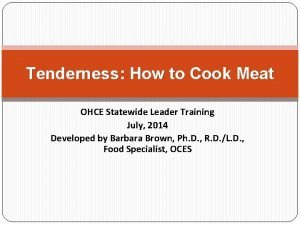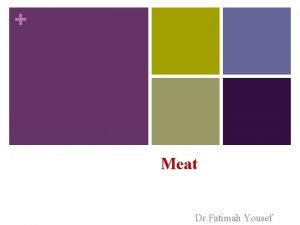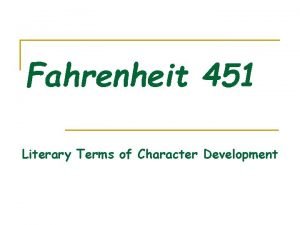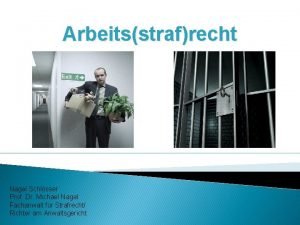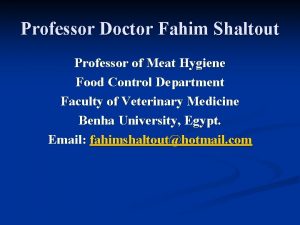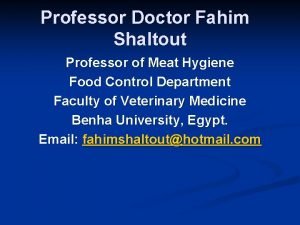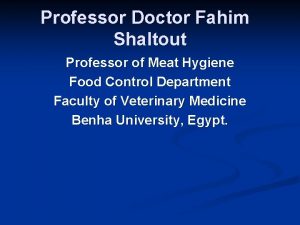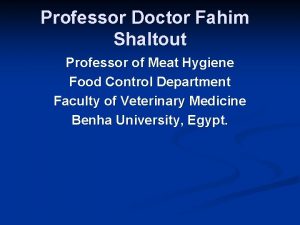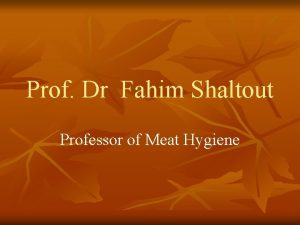MEAT COMPOSITION PROF DR FAHIM SHALTOUT PROFESSOR OF











- Slides: 11

MEAT COMPOSITION PROF. DR. FAHIM SHALTOUT PROFESSOR OF MEAT HYGIENE FACULTY OF VETERINARY MEDICINE PROFESSOR BENHA UNIVERSITY, EGYPT EMAIL: FAHIMSHALTOUT@HOTMAIL. COM

Butcher’s meat is a valuable part of the human diet because 1 -It is the most concentrated and easily assimilable nitrogenous food and is a good source of first-class protein (essential amino acids). 2 -Stimulate metabolism due to its high protein content, so help the body to produce heat & energy. 3 -It is satisfying (delay hunger ) due to high fat which remain in the stomach for hours 4 -Meat after suitable treatment (ripening and cooking) acquire apalatable flavour which acts as a stimulant to gastric secretion and facilitate digestion

Definition of meat 1)Broad meaning def Meat means all parts of warm blooded animals used for food By this meaning meat does not only wean muscles but also all other tissues which could be consumed 2) narrow meaning def Meat means the edible part of skeletal muscles (mainly muscle tissue and related c. t. , fatty tissue, nerves, bl. Vessels, lymph vessels & Lymph nodes) and other remain edible tissues which are connected with muscles not separated from it ie: fat bones, ligaments & tendons, if separated form muscles not defined as meat.

3) US Department of Agriculture definition: Meat mean the edible part of skeletal muscles as well as what are commonly known as a variety meats as tongue, diaphragm, heart esophagus, glandular meats from brain, liver, kidney, thymus spleen, pancreas, and stomach lining

Meat composition Meat is composed of: 1) Muscles. 2) Connective tissue: 3) Fatty tissue.

Structure of skeletal Muscles - skeletal Ms Consists of long cross striated multinucleated muscle fibers - each muscle fiber composed of: Sarcolemma, Mvofibrils, Sarcoplasm, Nuclei

Types of connective tissue fiber: Two main types Collagenous fibers (white c, t, ) Reticular fibers Elastic fibers (Yellow ct. )

Effect of collagen fibers on meat quality 1 -Tenderness: Increased number of collagenous fibers in the muscle leads to decreased tenderness of the muscle, because collagen less tender than the muscle Eg: chuck contain high % of collagen Loin contain low % of collagen 2 -Cooking: Collagen to be converted to gelatin, it needs heat and moistur So, muscles with high percent of collagen as chuck need. prolonged period of heating or moist heat cookery ie more collagenous fibers increase period of cooking 3 -Old meat By progress of the age of the animal, the number of’ covalent bands increase, this leads to that collagen less soluble & when heated the percentage of collagen changed to gelatin is decreased This explain why older meat is tougher and need long time on heating.

Fatty tissue Meat contains two classes of fats 1 -Storage fat or fat depots 2 -Intramuscular fat or structural fat - Fat affect the odour & flavour of different meat in which the intramuscular fat is responsible for aroma flavour and juciness of the product - The deposition of fat between the muscle fibers is a desirable feature and is known as Marbling which occurs in young and well nourished cattle, not in old animal where fat tend to be deposited S/C.

Chemical composition of meat 1 -Water 75% a- Bound water b-Free water c- Immobilized water 2 -Proteins a- Myofibril proteins b- Sarcoplasmic proteins c- C. T. proteins 3 - Fat 4 -Carbohydrates Lactic acid

Glycogen 0. 15% Glucose — 6 — phosphate 0. 1% Glucose 0. 05% 5 -Miscellaneous soluble non protein substances 2. 3% a- Nitrogenous sub. 1. 65% b-In organic sub. 0. 65% 6 -Vitamins minute quantities Vitamin B-coplex present adequatly B 1, B 2, B 6, B 12 and other water & fat soluble vitamins quantitatively minute 7 -Minirals less than 1%(0. 65%) Sulphur potassium phosphorus sodium chlorine magnesium iron & zinc 8 -Other constituents Pigments Reducing bodies.


